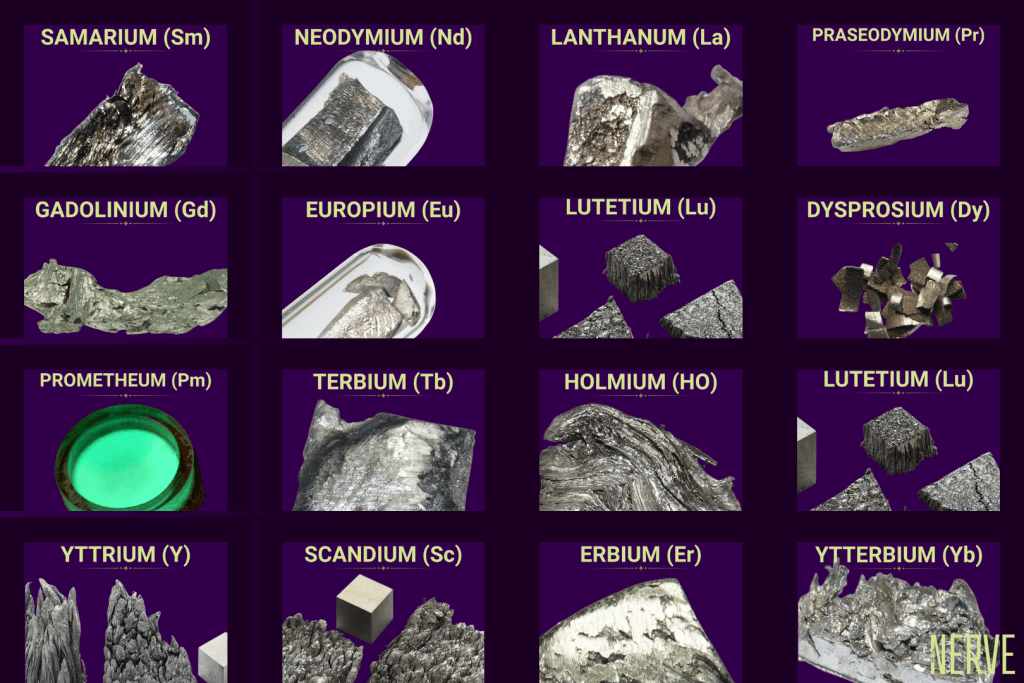Why you need this primer:
What do the smartphone in your pocket, an electric car, and an F-35 fighter jet have in common?
They are all powered by a group of seventeen obscure metals known as Rare Earth Elements (REEs).
From the precision guidance in a Tomahawk missile to the motors in wind turbines and the polished glass on every screen you own, our most advanced systems are critically dependent on them. A single F-35 fighter jet requires over 800 lbs of these materials to function; a Virginia-class submarine needs nearly 9,000 lbs.
China fundamentally restructured its export control scheme governing its Rare Earth Elements, in a move that can only be interpreted as a direct targeting of US military production and American industrial capacity writ large. It’s a decision that sent shockwaves through the global markets.
The October 9th announcement constitutes the second phase of their attempt to leverage the REE sector, and, in addition to their expansion of the controlled mineral list from its original 7 elements to 12, China has devised a way to retaliate against Uncle Sam’s maneuvers in the semicondoctor sector via its own version of the Foreign Direct Product Rule. A complete breakdown of their announcement is available in it’s standalone Nerve Primer, but in this edition we’re going to be answering a more fundamental question: what makes REEs critical to national security.
What are Rare Earth Elements?
The security and technological superiority of the United States in the 21st century are inextricably linked to a group of seventeen metallic elements known as Rare Earth Elements. Their unique magnetic, luminescent, and catalytic properties make them indispensable components in the nation’s most advanced military platforms and critical industrial sectors.
Despite their name, these elements are relatively abundant, but they are only present in abundant, economically viable concentrations in a few select regions of the world. Nearly all of these locations fall within China’s immediate sphere of influence.
REEs are not a monolithic group; a critical distinction exists between Light Rare Earth Elements (LREEs) and the scarcer, more valuable Heavy Rare Earth Elements (HREEs). This geological reality translates directly into a tiered structure of geopolitical risk. HREEs, such as dysprosium and terbium, are essential for enabling high-performance permanent magnets to function under the extreme temperatures found in missile guidance systems, jet fighter actuators, and electric vehicle motors. The processing of these HREEs is a near-exclusive monopoly of China, creating an acute strategic chokepoint.
An F-35 Lighting II is reported to require over 800 lbs of REEs.
An Arleigh Burke-class destroyer requires closer to 5,000 lbs of REEs and a quantity at least twice that number is required for a Virginia-class submarine.
The Light Rare Earth Elements (LREEs)
Light Rare Earth Elements (LREEs) generally include lanthanum (La), cerium (Ce), praseodymium (Pr), neodymium (Nd), promethium (Pm), samarium (Sm), europium (Eu), and gadolinium (Gd). These elements are relatively more abundant in most REE-bearing ore bodies, such as bastnasite and monazite, which are the primary sources for mines in the United States (Mountain Pass) and Australia (Mount Weld).
Lanthanum
National Security Application:
- Used in high-quality optical lenses for military surveillance and reconnaissance systems, as well as in radar and sonar transducers. It is also a component in nickel-metal hydride (NiMH) batteries for various defense equipment.
General Critical Input:
- Essential as a catalyst in petroleum refining to produce fuels like jet fuel. It is a primary component of NiMH batteries used in hybrid vehicles and is used to create high-refractive-index glass for camera and telescope lenses.
Cerium
National Security Application:
- Used as a polishing agent for precision optics in targeting and surveillance systems. It is also a component in thermal imaging systems for combat vehicles and in aerospace polishing.
General Critical Input:
- A vital component in automotive catalytic converters to reduce emissions. It is the industry standard for polishing virtually all glass products, from mirrors to television screens, and is a key ingredient in mischmetal for lighter flints.
Praseodymium
National Security Applications:
- A key component in high-strength Neodymium-Iron-Boron (NdFeB) permanent magnets used in actuators for guided weapons, UAVs, and aircraft flight controls. It is also used in high-strength alloys for aircraft engines and in specialized glass for military-grade monitors and head-up displays (HUDs).
General Critical Input:
- A primary component, along with neodymium, of the powerful NdFeB magnets that drive electric vehicle (EV) motors and wind turbines. It is also used as a colorant for glass and ceramics and in didymium glass for welder’s safety goggles.
Neodymium
National Security Applications:
- The foundational element for the strongest permanent magnets (NdFeB), which are indispensable for precision guidance systems in Tomahawk missiles, actuators in F-35 fighter jets, and motors in UAVs. It is also the active medium in Nd:YAG lasers used for target designation and range-finding in systems like the M1 Abrams tank.
Critical Industrial Input:
- The dominant element in NdFeB magnets used in EV motors, wind turbine generators, computer hard drives, speakers, and cordless tools.
Promethium
National Security Applications:
- Used in long-life nuclear batteries (beta-voltaic cells) that provide power for specialized military equipment, missile systems, and space probes where conventional power sources are not feasible. It has also been used in luminous paints for aircraft dials.
Critical Industrial Input:
- Provides power for medical devices like pacemakers. It is also used in portable X-ray sources and thickness-measurement devices for industrial inspection.
Samarium
National Security Applications:
- The key element in Samarium-Cobalt (SmCo) magnets, which are valued for their high thermal stability and are essential for missile guidance systems (e.g., AIM-120 AMRAAM), radar systems (Patriot and Aegis), and electronic warfare equipment where performance under extreme heat is critical.
Critical Industrial Input:
- Used in high-performance SmCo magnets for high-temperature motors, sensors, and magnetic couplings in the aerospace, automotive, and manufacturing industries. It also serves as a control rod material in nuclear reactors.
Europium
National Security Applications:
- Provides the essential red and blue phosphors for high-resolution military-grade monitors, avionics displays, and night-vision systems, enabling superior situational awareness. Its fluorescent properties are also used as an anti-counterfeiting measure.
Critical Industrial Input:
- The primary red phosphor used in all commercial color television and computer screens, as well as in energy-efficient fluorescent lighting. It is also used in nuclear reactor control rods.
Gadolinium
National Security Applications:
- Has an exceptionally high ability to absorb neutrons, making it valuable for shielding in nuclear-powered submarines and other radiation-sensitive military assets. It is also used in sonar transducers and devices for detecting gamma-ray radiation.
Critical Industrial Input:
- Its unique paramagnetic properties make it the essential contrast agent for Magnetic Resonance Imaging (MRI) scans. It is also used in nuclear reactor shielding.
The Heavy Rare Earth Elements (HREEs)
Heavy Rare Earth Elements (HREEs) include terbium (Tb), dysprosium (Dy), holmium (Ho), erbium (Er), thulium (Tm), ytterbium (Yb), lutetium (Lu), and yttrium (Y). HREEs are significantly less abundant in most deposits and are often found in different mineralogies, most notably the ion-adsorption clays of southern China, which have become the world’s primary source.
Scandium
National Security Application:
- Provides the essential red and blue phosphors for high-resolution military-grade monitors, avionics displays, and night-vision systems, enabling superior situational awareness. Its fluorescent properties are also used as an anti-counterfeiting measure.
General Critical Input:
- The primary red phosphor used in all commercial color television and computer screens, as well as in energy-efficient fluorescent lighting. It is also used in nuclear reactor control rods.
Yttrium
National Security Application:
- Used as an alloying agent with aluminum to create lightweight, high-strength materials for military aerospace applications, including fighter jets.
General Critical Input:
- Used in solid oxide fuel cells, specialized lighting, high-performance ceramics, and electronics. It is also alloyed with aluminum for high-performance sporting goods.
Terbium
National Security Applications:
- A critical additive to NdFeB magnets to increase their thermal stability for use in military motors and actuators. It is also a component of the magnetostrictive material Terfenol-D, used in advanced sonar systems and for active vibration dampening in armored vehicles.
Critical Industrial Input:
- Provides the green phosphor for LED/LCD screens and fluorescent lighting. It is also a key additive for high-temperature NdFeB magnets used in EV motors and wind turbines.
Dysprosium
National Security Applications:
- A critical additive to NdFeB magnets to ensure they maintain their magnetic strength at the high operating temperatures found in aircraft, missile guidance systems, and naval vessels. It is also a component of Terfenol-D for sonar systems.
Critical Industrial Input:
- The primary additive for creating high-temperature NdFeB magnets used in EV motors and wind turbine generators. It is also used in nuclear reactor control rods and data storage applications.
Holmium
National Security Applications:
- Used in specialized lasers (Ho:YAG) for military targeting, range-finding, and emerging directed energy weapons. It has the highest magnetic moment of any element, allowing it to create extremely powerful magnetic fields for specialized applications and is used in radar-absorbing materials for stealth technology.
Critical Industrial Input:
- Used in medical lasers for surgical procedures and in nuclear reactor control rods.
Erbium
National Security Applications:
- The key element in Erbium-Doped Fiber Amplifiers (EDFAs), which are essential for boosting signals in secure, long-haul military fiber-optic communication networks. It is also used in lasers for targeting and in materials for night-vision systems.
Critical Industrial Input:
- The foundational element for EDFAs that form the backbone of global telecommunications, including the internet. It is also used in medical and dental lasers and as an alloying agent to improve the workability of metals like vanadium.
Thulium
National Security Applications:
- Used in high-efficiency lasers for military communications and surgery, as well as in portable X-ray sources for field diagnostics.
Critical Industrial Input:
- Used in medical lasers and portable X-ray machines. Its luminescent properties are used as an anti-counterfeiting feature in Euro banknotes.
Ytterbium
National Security Applications:
- A critical dopant for high-power fiber lasers, a key technology for future directed energy weapons and military LiDAR systems.
Critical Industrial Input:
- Used in fiber optic amplifiers and high-power fiber lasers for industrial cutting and welding. It is also used to strengthen stainless steel, in ultra-precise atomic clocks, and in quantum computing research.
Lutetium
National Security Applications:
- A key component in scintillator materials used in advanced devices that detect gamma-ray radiation, a critical capability for counter-proliferation and identifying nuclear threats.
Critical Industrial Input:
- The radioactive isotope Lu-177 is a groundbreaking agent in targeted cancer therapies. Lutetium is also used in scintillators for medical PET scans and as a catalyst in petroleum refining.
Post tags


























